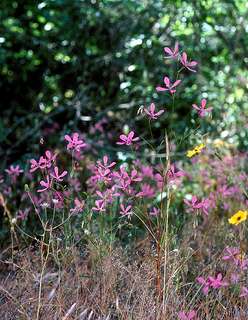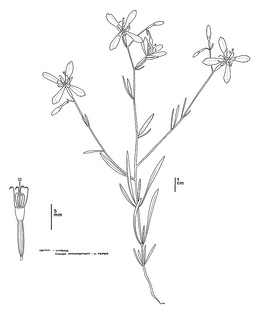(Clarkia lingulata)
 Clarkia lingulata. CDFW photo by James Bartel.
Clarkia lingulata. CDFW photo by James Bartel.
 Clarkia lingulata. CDFW illustration by Mary Ann Showers. (Click to enlarge)
Clarkia lingulata. CDFW illustration by Mary Ann Showers. (Click to enlarge)
Merced clarkia is a California endangered plant species, which means that killing or possessing the plant is prohibited by the California Natural Diversity Database (CNDDB), Merced clarkia has always been known from only two occurrences along Highway 140 in Mariposa County. Because it is an annual plant, Merced clarkia population numbers fluctuate every year, and tend to have higher numbers in years with more precipitation.
Merced clarkia was originally listed as rare by the California Department of Fish and Wildlife (CDFW) in 1982, but following an herbicide application that damaged both occurrences in 1984, it was uplisted to endangered in 1986. Both known occurrences of Merced clarkia are on land in the Sierra National Forest, but they occur along roadsides managed by the California Department of Transportation (Caltrans). When Merced clarkia was uplisted in 1986, there was no protection or management strategy in place by either Caltrans or the U.S. Forest Service. In 1994, a multi-agency Memorandum of Understanding (MOU) designed to protect and conserve sensitive species, including Merced clarkia, in the Merced River Canyon was signed by the following participating agencies: the U.S. Forest Service (USFS), Bureau of Land Management, Caltrans, CDFW, and Pacific Gas and Electric. The MOU provides guidelines for highway and power line maintenance and repair, notification requirements, species monitoring, and annual reviews. Merced clarkia is also included in the PG&E San Joaquin Valley Operations and Maintenance Habitat Conservation Plan (HCP), completed in 2007.
The main threats faced by Merced clarkia are road maintenance, grazing, fire, and encroachment of invasive species, such as yellow star thistle (Centaurea solstitialis). The MOU and HCP both provide measures that protect Merced clarkia from road maintenance activities. Because its range is so limited and it occurs on or near steep slopes, Merced clarkia also faces the threat of extinction due to a stochastic event, such as flooding or a landslide.
To ensure the continued existence of Merced clarkia, the USFS and Caltrans should continue to work cooperatively to ensure that management activities do not negatively affect either occurrence. Additionally, the USFS should continue yearly monitoring of Merced clarkia, as the most recent population data available in the CNDDB is from 1998. Research should be conducted on Merced clarkia to assess what factors impact its annual reproduction rate. Additionally, seed should be collected and placed into long-term storage at a qualified seed banking facility.
CDFW may issue permits for Merced clarkia pursuant to CESA, and you can learn more about the California laws protecting Merced clarkia and other California native plants. Populations of Merced clarkia occur in CDFW’s Central Region.
Updated 01/14/2014